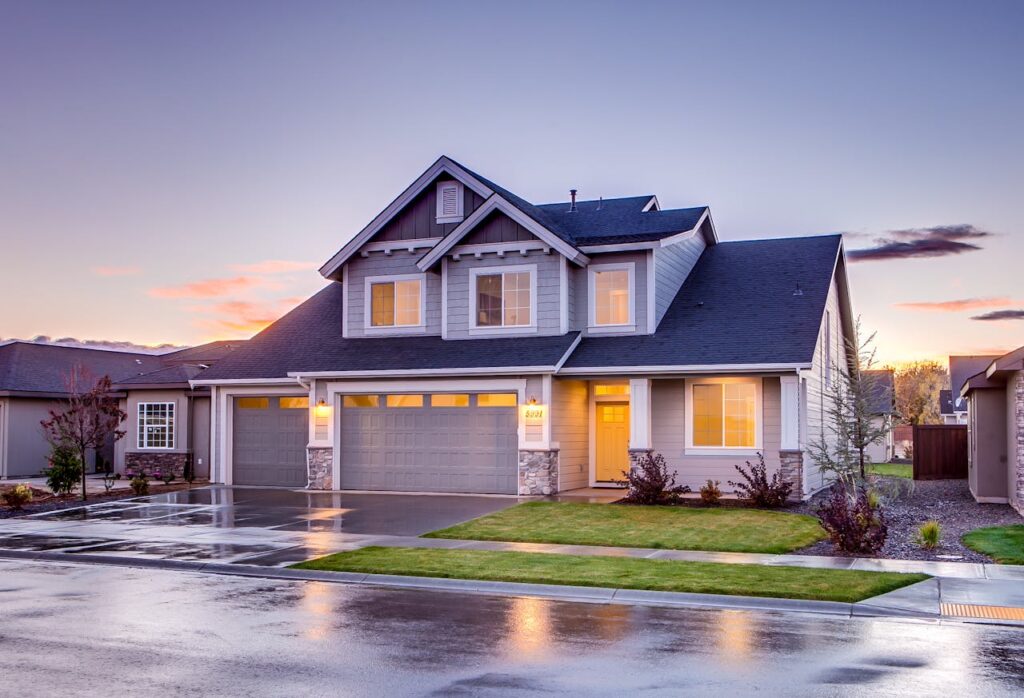It’s estimated that off-street parking adds around 5% to the value of a house. But more than that, it’s incredibly handy on busy residential roads as it saves the daily hassle of finding a space. Plus, it increases the security of your parked car and could reduce your insurance. So, there are plenty of benefits to creating a driveway.
If you’re looking for a durable and low-maintenance driveway, you might be considering a tarmac one. However, the average tarmac driveway cost lies somewhere between £1,000 and £8,000. So, you might be wondering how you can get the most out of the installation to ensure your money isn’t wasted. Here’s eight tips that will help.

Photo by Binyamin Mellish: https://www.pexels.com/photo/blue-and-gray-concrete-house-with-attic-during-twilight-186077/
Prep it
The trick to a good-looking tarmac driveway is getting the base right. This ensures you end up with a smooth, even surface that stays free of lumps and bumps. It will also stop sections from sinking over time and reduce the chances of cracks appearing. The addition of a weed control membrane will help prevent weeds popping up through it too. Although you might fancy saving yourself some cash by doing the prep yourself, to be sure you get the best finish, it’s best to get the job done professionally.
Shape it
The beauty of tarmac is it can fill any size and shape of space. So, make the most of this by designing your driveway to maximise kerb appeal and functionality. Giving your home a sweeping entrance makes it feel grander and allowing your driveway to widen near the gate makes it easier to get your car in and out. Plus, adding curves to your driveway can help to make borders look more interesting.
Edge it
It can be hard to get a neat finish to your tarmac driveway and clearly zone the space without the help of some edging. You could go for a thin strip of grey stone to create a modern, clean-lined appearance. But to increase the character and style of your exterior, you might prefer to use sandstone pavers or red bricks for a bit of contrast or perhaps some scalloped edging stones for extra patterning. You might also consider raised kerbing with a rounded edge. This makes it easier to detect when your car is nearing sides of the driveway, saving you from accidentally driving over lawned areas and flower beds.
Colour it
With tarmac, you don’t need to stick to the standard colour. If you think it will make your exterior look too dark, you could go with a lighter grey or a buff colour tarmac instead. And if you want to stand out, a bold colour such as red might be more up your street. Choosing a coloured tarmac means you can customise your driveway to suit your house and your personality.
Seal it
Sealing a tarmac driveway will help to keep it in good condition. A good quality sealant helps to protect it from extreme weather conditions while improving the surface friction, so it’s better and safer to drive on. It’s recommended that you reseal your driveway every five years or so, to retain the integrity of the tarmac and prevent fading.
Soften it
The hard surface of a tarmac – or any other driveway – can look quite harsh and empty. So, to make sure the front or side of your home still looks attractive and welcoming, it’s a good idea to soften the area with some planting. Even a narrow border can accommodate a few bright flowers or some textural grasses. If you have more space, then an area of lawn, a small tree or some low hedging could be used to boost the appeal.
Light it
If you don’t have the luxury of always arriving home in the daylight or frequently have guests visiting in the evenings, you might want to consider sinking some lights into your tarmac driveway. Not only will this illuminate your way but it won’t take up any extra space. And doing this can make your driveway feel more expensive.
Clean it
Keeping your tarmac driveway clean and well maintained will ensure it stays looking good. Along with sealing it periodically, it’s a good idea to sweep it regularly and hose it down with a mild detergent or tarmac cleaner to get rid of residual dirt and debris. However, you should avoid using high-pressure hoses as this can damage your surface.

